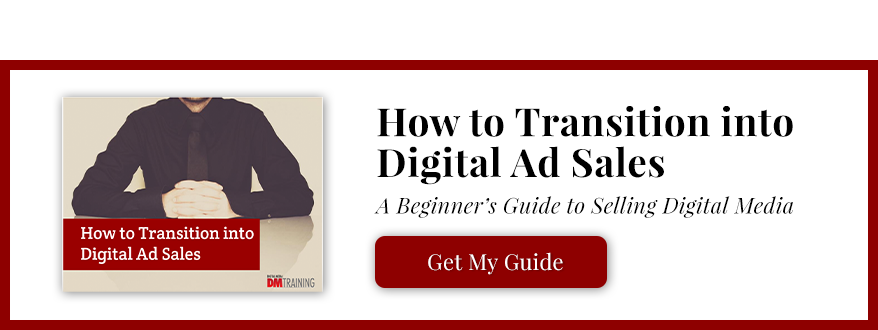Converting Digital Data into Sales Success Stories
It is a common challenge among many media organizations, and businesses in general, they are swimming in data from a variety of sources and platforms, yet uncertainty remains when it comes to identifying ways to improve or enhance sales efforts.
The real problem is not being able to connect data with insight.
Data is the guiding element for creating effective (and interesting) success stories. Meant to summarize how and why you worked with a particular client as it relates to the current sales opportunity at hand.
For the purposes of this post, data is referring to a collection of what is known about a segment of people and their attributes. For example, common attributes are demographics, device, location, etc. This includes data collected from your digital assets too, such as: your website, CRM, social media pages, paid advertising, etc.
So, what data should you be looking at? And how do you convert it into a story that helps you sell more effectively?
Let’s break this down into 4 considerations:
- Category - what markets, industries and verticals are you going after?
- Purpose - why should your audience care?
- Referrals - how are you working with partners?
- Opportunities - where can we improve and expand?
These 4 considerations will help you convert your data into engaging sales stories that offer measurable solutions for your clients. Let's dive in.
Looking to make the leap to selling digital media? Get our eBook for tips on making a successful transition.
Category
The first consideration is category.
In other words, what category of companies (markets, industries and verticals) are you going after? Where are you seeing the most success?
As a media seller, you need to identify your top 3-5 categories and develop a success story that corresponds with each.
For example, let’s say you’re a rep selling ads for a premium publisher. You’re going after the SMB market and have had success working with local restaurants and retail stores.
How can you turn this example into a story that will help you effectively position your solution to a similar company?
You can highlight these key areas:
- What was the goal of the campaign? This is where you’ll want to explain what your client was trying to accomplish and what KPIs they used to measure success. For example, a goal for a local restaurant might be to increase the number of people in their loyalty program or the number of positive reviews listed on Yelp.
- Who was the target audience? What kind of audience and targeting capabilities do you have? Perhaps you can segment the ideal customer by combining demographic, lifestyle and interests, media preferences, and in-market characteristics. Or perhaps audience extension comes into play. For example, if you’re working with a local restaurant who is announcing a grand opening of a new location, you’ll want to segment individuals who are not only local to the new area but also individuals who are foodies and travel enthusiasts.
- What was included and where did the campaign run? This is your opportunity to illustrate how and why your solution set will help your client achieve their goals. Consumers are constantly engaged across multiple platforms and devices, which means your campaign needs to be omnichannel. And with access to powerful data like type of device, browser, time of day, etc., you can identify your prospects’ media preferences and effectively reach them on their favorite platforms. In fact, publishers, brands, and advertisers who engage with audiences through multi-channel campaigns see incremental sales lift in comparison to a single channel campaign. For example, it’s essential to deliver relevant content to the target audience across media where they are most engaged in order to drive sales – whether it’s through sending email blasts, delivering display ads on web browsers, engaging on social media, or sending push notifications to mobile.
- What was the ROI? The last, but certainly not least important piece of the story, what was the return on investment for your client? In other words, if your client invested $10K and achieved $25K in new business as a result, then they would get a 1.5% return on their investment. In this part of the story, you’ll not only want to emphasize the importance of measurement, but also the longer term benefits like: deciding what to spend on for future campaigns, justifying marketing spending to internal teams, comparing marketing efficiency with competitors, and finally, it holds everyone accountable.
Highlighting these key areas will help you craft a story for every category you’re working within. And it will enable you to paint the picture of success and help your potential client understand how your solution fits into what they need and aligns their overall goals.
Purpose
The second consideration is purpose.
What purpose does your website or platform serve? How are you delivering value? Why would someone engage on the website or platform?
We need to answer these questions in a compelling way in order to differentiate ourselves from all the other media solutions out there. To do that, you must look at and assess the data collected from the interactions and engagements that occur on your website and/or other media properties.
For example, take the number of website visitors as a metric, and then ask yourself some of these questions;
- What’s the rationale for the number of visitors to the site?
- What’s the most popular page, or piece of content, visitors are engaging with?
- What’s the average amount of time a visitor spends on the site? Average number of page views?
- Are people visiting your site because they’re at the bottom of the marketing funnel, ready to take action?
- Are they visiting from social media sites? Other referrals?
- Are they coming to your site directly from a search engine results listing that they’ve clicked on?
- Where are all these visitors really coming from?
The more you understand the reasons why people visit your website or platform, the better you will be able to explain the purpose and value you can offer to brands and advertisers looking to work with you.
Referral Traffic
The third consideration is referral traffic.
Referral traffic provides information around how users are getting to your website. These users have been gently nudged from somewhere else to click through to your site and this is important because if you figure out why they’re clicking through (or at least have a good idea), you can leverage that information to increase direct and repeat traffic to your site.
In addition, referral traffic has SEO benefits. When someone visits your website from another site they are usually clicking on a link or completing some type of social activity. Google and other search engines consider these links and social signals as positive ranking factors as long as they are coming from trusted websites.
This in turn gets your content (or your client’s content) in front of new people, giving your website the opportunity to convert that visitor into a lead and your client the opportunity to convert that lead into a new customer.
As you build this piece of your story, talk about how referral partnerships extend audience reach and increases the number of new leads being generated.
Opportunities
Lastly, let’s look at opportunities as our final consideration.
Based on the data you’ve collected, what areas can you optimize?
Now that you’ve identified your top targets based on the company categories you’ve had success with, it’s time to consider how to expand within these categories and what other areas are worth pursuing.
For example, if you’re having success with local restaurants but haven’t explored working with local travel agencies, then consider the overlap that exists between these two categories and try to experiment with it.
When looking at your website data and how to leverage it, think about and ask yourself: “How many different ways are visitors engaging across the site and digital properties? And what types of engagements should be setup to most effectively do so?”
Here are some things to consider while assessing and planning this out:
- Is there popular content that we can repurpose or build upon to help increase lead generation and the value being provided to our audience?
- What other ways can we drive unique visitors to our website?
- What are our competitors doing? Should we respond to their efforts? Is there anything worth replicating?
- In terms of website data, what’s our advantage vs. the competitors? Number of page views? Time on site? Number of returning visitors or subscribers? Etc.
The bottom line: Use data to help you create a compelling story and positioning statement about why your audience is in fact more open, loyal, and likely to engage with relevant advertising.
As soon as all of these pieces come together, you’ll see your prospects reacting and engaging in a positive way. You’ll tell stories that interest while also providing important and valuable information on how data backs up these claims. It’s what’s going to bring our data to life. So in conclusion, how can you make your stories sound more interesting?
By taking a closer look at our customer data and metrics, we can gain a better understanding of how people are interacting with your digital assets and using your solution. As a result, you’ll better attract and retain clients.
If you’re thinking about making a career change to digital or you want to learn more about possible opportunities, check out our eBook for more tips on how to make a success transition.
About Molly D Protosow
Molly Protosow is the COO and Training Strategist for DMTraining. She manages the day-to-day business and training operations while helping research and develop new training programs as well as refreshing signature programs to reflect the newest sales trends, technology, and best practices. Molly utilizes her wide-range of skills to create sales and marketing assets focused on delivering value to DMT’s clients. Molly has a passion for learning and leveraging new knowledge and experiences. Outside of DMTraining, Molly is a hard core Pittsburgh sports fan, enjoys staying active by running and golfing, and unwinds by reading and playing the piano.






